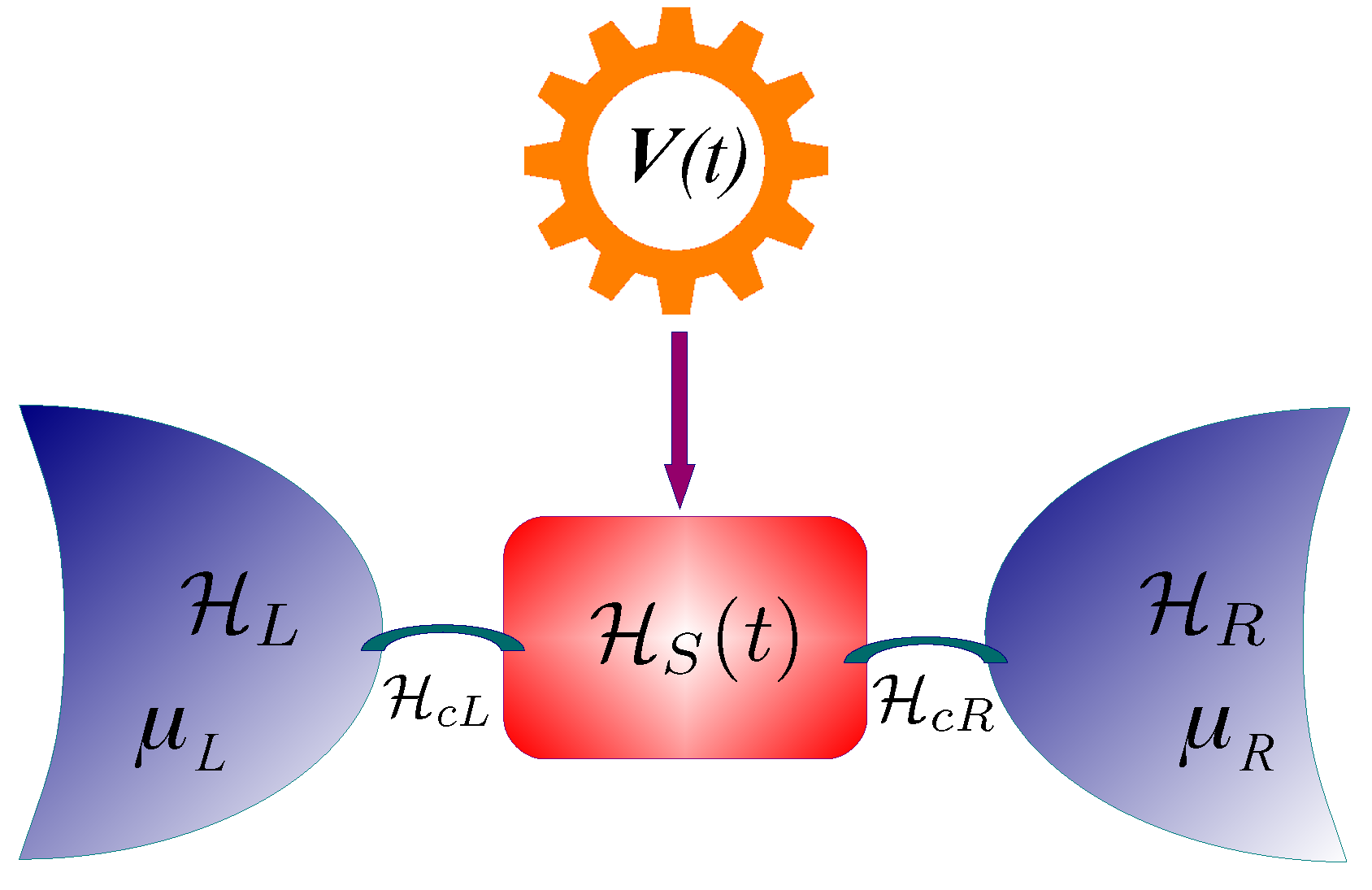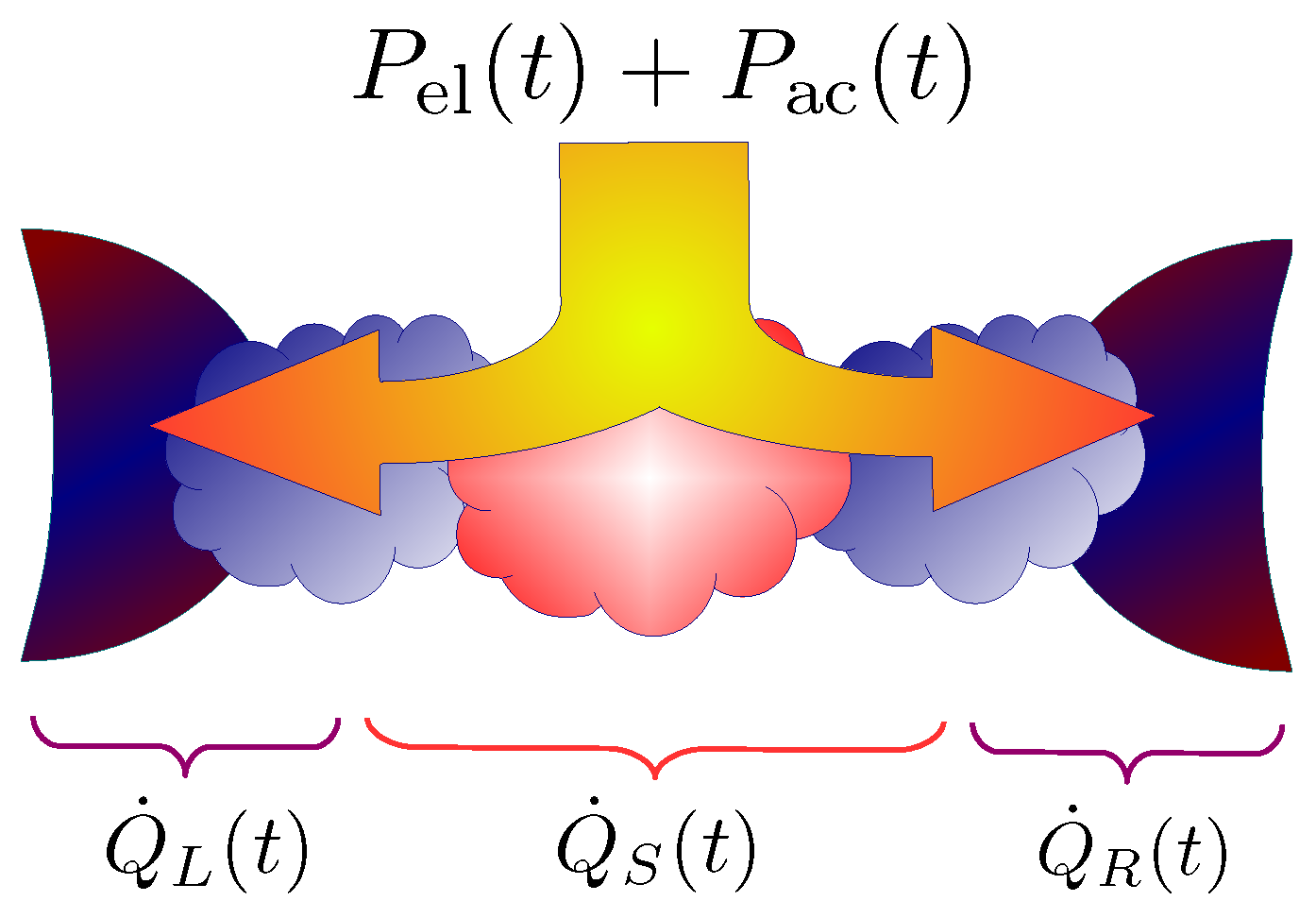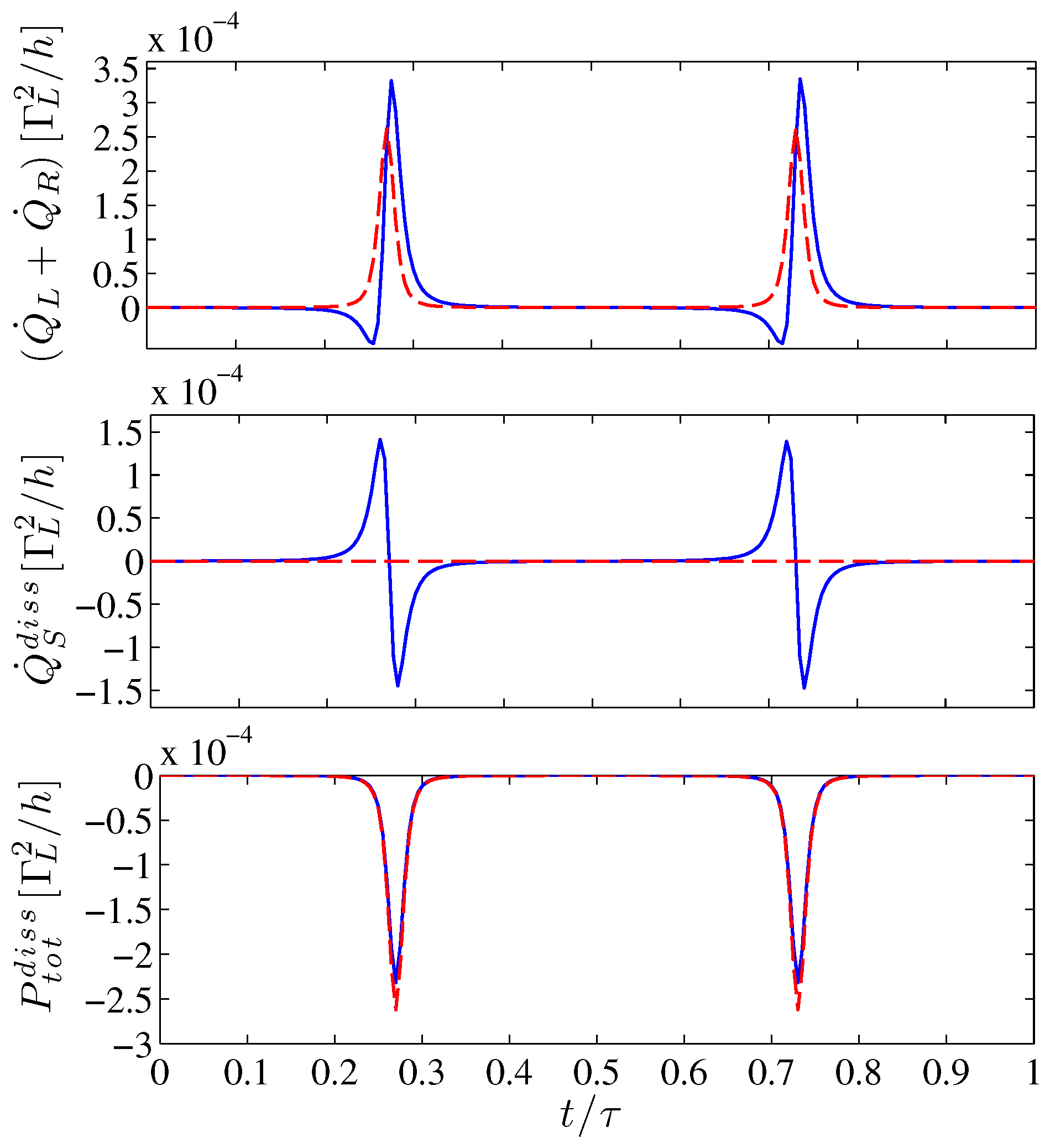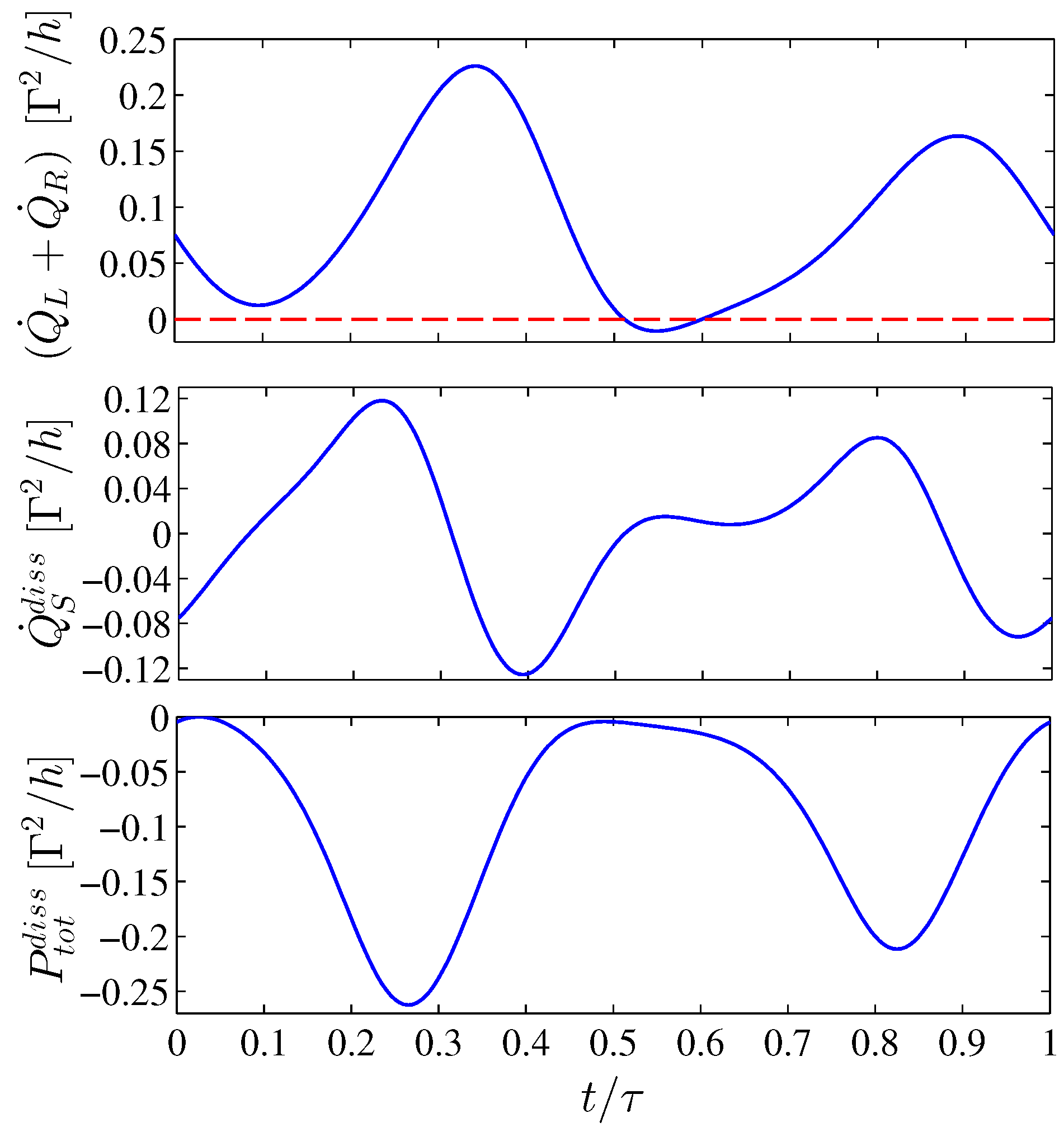Periodic Energy Transport and Entropy Production in Quantum Electronics
Abstract
:1. Introduction
2. Theoretical Model
3. First Law
4. Heat Current and Power
- It leads at low frequencies to a correct Joule law valid for all times [52].
- It shows perfect agreement between the Green function approach and the scattering matrix formalism [52].
- It displays parity symmetry upon reversal of the AC frequency even for interacting quantum conductors [79].
- It reduces to the conventional definition in the stationary case since the term vanishes after time averaging [53].
5. Entropy Production
6. Calculation of the Currents within Green’s Function Approach for Non Interacting Systems
6.1. Time Resolved Charge and Energy Currents Entering the Reservoirs
6.2. Energy Stored in the Contact Regions
6.3. Power Developed by the AC Sources
7. Relation to the Scattering Matrix Formalism
8. Low Frequency Expansion
9. Application
9.1. Adiabatic Regime and Linear Response in the Bias Voltage
9.2. Nonadiabatic Regime
10. Conclusions
Acknowledgments
Author Contributions
Conflicts of Interest
References
- Benenti, G.; Casati, G.; Saito, K.; Whitney, R.S. Fundamental aspects of steady-state conversion of heat to work at the nanoscale. arXiv, 2016; arXiv:1608.05595. [Google Scholar]
- Kosloff, R. Quantum thermodynamics: A dynamical viewpoint. Entropy 2013, 15, 2100–2128. [Google Scholar] [CrossRef]
- Campisi, M.; Fazio, R.J. Dissipation, Correlation and Lags in Heat Engines. Phys. A Math. Theor. 2016, 49, 345002. [Google Scholar] [CrossRef]
- Gasparinetti, S.; Solinas, P.; Pugnetti, S.; Fazio, R.; Pekola, J.P. Environment-governed dynamics in driven quantum systems. Phys. Rev. Lett. 2013, 110, 150403. [Google Scholar] [CrossRef] [PubMed]
- Segal, D. Heat transfer in the spin-boson model: A comparative study in the incoherent tunneling regime. Phys. Rev. E 2014, 90, 012148. [Google Scholar] [CrossRef] [PubMed]
- Carrega, M.; Solinas, P.; Sassetti, M.; Weiss, U. Energy Exchange in Driven Open Quantum Systems at Strong Coupling. Phys. Rev. Lett. 2016, 116, 240403. [Google Scholar] [CrossRef] [PubMed]
- Schmidt, R.; Carusela, M.F.; Pekola, J.P.; Suomela, S.; Ankerhold, J. Work and heat for two-level systems in dissipative environments: Strong driving and non-Markovian dynamics. Phys. Rev. B 2015, 91, 224303. [Google Scholar] [CrossRef]
- Ponomarev, A.V.; Denisov, S.; Hänggi, P. AC-Driven Atomic Quantum Motor. Phys. Rev. Lett. 2009, 102, 230601. [Google Scholar] [CrossRef] [PubMed]
- Abah, O.; Roßnagel, J.; Jacob, G.; Deffner, S.; Schmidt- Kaler, F.; Singer, K.; Lutz, E. Single-ion heat engine at maximum power. Phys. Rev. Lett. 2012, 109, 203006. [Google Scholar] [CrossRef] [PubMed]
- Brantut, J.-P.; Grenier, C.; Meineke, J.; Stadler, D.; Krinner, S.; Kollath, C.; Esslinger, T.; Georges, A. A thermoelectric heat engine with ultracold atoms. Science 2013, 342, 713–715. [Google Scholar] [CrossRef] [PubMed]
- Uzdin, R.; Levy, A.; Kosloff, R. Equivalence of quan- tum heat machines, and quantum-thermodynamic signatures. Phys. Rev. X 2015, 5, 031044. [Google Scholar]
- Blickle, V.; Bechinger, C. Realization of a micrometer-sized stochastic heat engine. Nat. Phys. 2011, 8, 143–146. [Google Scholar] [CrossRef]
- Martínez, I.A.; Roldán, E.; Dinis, L.; Petrov, D.; Rica, R.A. Adiabatic Processes Realized with a Trapped Brownian Particle. Phys. Rev. Lett. 2015, 114, 120601. [Google Scholar] [CrossRef] [PubMed]
- Scully, M.O. Quantum photocell: Using quantum co-herence to reduce radiative recombination and increase efficiency. Phys. Rev. Lett. 2010, 104, 207701. [Google Scholar] [CrossRef] [PubMed]
- Steeneken, P.G.; Le Phan, K.; Goossens, M.J.; Koops, G.E.J.; Brom, G.J.A.M.; van der Avoort, C.; van Beek, J.T.M. Piezoresistive heat engine and refrigerator. Nat. Phys. 2010, 7, 354–359. [Google Scholar] [CrossRef]
- Scully, M.O.; Zubairy, M.S.; Agarwal, G.S.; Walther, H. Extracting work from a single heat bath via vanishing quantum coherence. Science 2003, 299, 862–864. [Google Scholar] [CrossRef] [PubMed]
- Chamon, C.; Mucciolo, E.R.; Arrachea, L.; Capaz, R.B. Heat Pumping in Nanomechanical Systems. Phys. Rev. Lett. 2011, 106, 135504. [Google Scholar] [CrossRef] [PubMed]
- Arrachea, L.; Mucciolo, E.R.; Chamon, C.; Capaz, R.B. Microscopic model of a phononic refrigerator. Phys. Rev. B 2012, 86, 125424. [Google Scholar] [CrossRef]
- Steele, G.A.; Hẗtel, A.K.; Witkamp, B.; Poot, M.; Meerwaldt, H.B.; Kouwenhoven, L.P.; van der Zant, H.S.J. Strong coupling between single-electron tunneling and nanomechanical motion. Science 2009, 325, 1103–1107. [Google Scholar] [CrossRef] [PubMed]
- Lotze, C.; Corso, M.; Franke, K.J.; von Oppen, F.; Pascual, J.I. Driving a macroscopic oscillator with the stochastic motion of a hydrogen molecule. Science 2012, 338, 779–782. [Google Scholar] [CrossRef] [PubMed]
- Brandner, K.; Saito, K.; Seifert, U. Thermodynamics of micro- and nano-systems driven by periodic temperature variations. Phys. Rev. X 2015, 5, 031019. [Google Scholar] [CrossRef]
- Horowitz, J.M. Quantum-trajectory approach to the stochastic thermodynamics of a forced harmonic oscillator. Phys. Rev. E 2012, 85, 031110. [Google Scholar] [CrossRef] [PubMed]
- Martinez, E.A.; Paz, J.P. Dynamics and thermodynamics of linear quantum open systems. Phys. Rev. Lett. 2013, 110, 130406. [Google Scholar] [CrossRef] [PubMed]
- Freitas, N.; Paz, J.P. Fundamental limits for cooling of linear quantum refrigerators. arXiv, 2016; arXiv:1607.04234. [Google Scholar]
- Arrachea, L.; Moskalets, M.; Martin-Moreno, L. Heat production and energy balance in nanoscale engines driven by time-dependent fields. Phys. Rev. B 2007, 75, 245420. [Google Scholar] [CrossRef]
- Rey, M.; Strass, M.; Kohler, S.; Hänggi, P.; Sols, F. Nonadiabatic electron heat pump. Phys. Rev. B 2007, 76, 08533. [Google Scholar] [CrossRef]
- Juergens, S.; Haupt, F.; Moskalets, M.; Splettstoesser, J. Thermoelectric performance of a driven double quantum dot. Phys. Rev. B 2013, 87, 245423. [Google Scholar] [CrossRef]
- Moskalets, M.; Büttiker, M. Heat production and current noise for single- and double-cavity quantum capacitors. Phys. Rev. B 2009, 80, 081302. [Google Scholar] [CrossRef]
- Bustos-Marun, R.; Refael, G.; von Oppen, F. Adiabatic Quantum Motors. Phys. Rev. Lett. 2013, 111, 060802. [Google Scholar] [CrossRef] [PubMed]
- Arrachea, L.; von Oppen, F. Nanomagnet coupled to quantum spin Hall edge: An adiabatic quantum motor. Physica E 2015, 74, 596–602. [Google Scholar] [CrossRef]
- Daré, A.M.; Lombardo, P. Time-dependent thermoelectric transport for nanoscale thermal machines. Phys. Rev. B 2016, 93, 035303. [Google Scholar] [CrossRef]
- Zhou, H.; Thingna, J.; Hänggi, P.; Wang, J.-S.; Li, B. Boosting thermoelectric efficiency using time-dependent control. Sci. Rep. 2015, 5, 14870. [Google Scholar] [CrossRef] [PubMed]
- Ludovico, M.F.; Battista, F.; von Oppen, F.; Arrachea, L. Adiabatic response and quantum thermoelectrics for AC-driven quantum systems. Phys. Rev. B 2016, 93, 075136. [Google Scholar] [CrossRef]
- Bergenfeldt, C.; Samuelsson, P.; Sothmann, B.; Flindt, C.; Büttiker, M. Hybrid microwave-cavity heat engine. Phys. Rev. Lett. 2014, 112, 076803. [Google Scholar] [CrossRef] [PubMed]
- Biele, R.; D’Agosta, R.; Rubio, A. Time-dependent thermal transport theory. Phys. Rev. Lett. 2015, 115, 056801. [Google Scholar] [CrossRef] [PubMed]
- Alicki, R.; Gelbwaser-Klimovsky, D.; Szczygielski, K. Solar cell as self-oscillating heat engine. J. Phys. A Math. Theor. 2016, 49, 015002. [Google Scholar] [CrossRef]
- Alicki, R. Thermoelectric generators as self-oscillating heat engines. J. Phys. A Math. Theor. 2016, 49, 085001. [Google Scholar] [CrossRef]
- Kindermann, M.; Pilgram, S. Statistics of heat transfer in mesoscopic circuits. Phys. Rev. B 2004, 69, 155334. [Google Scholar] [CrossRef]
- Averin, D.V.; Pekola, J.P. Violation of the Fluctuation-Dissipation Theorem in Time-Dependent Mesoscopic Heat Transport. Phys. Rev. Lett. 2010, 104, 220601. [Google Scholar] [CrossRef] [PubMed]
- Sergi, D. Energy transport and fluctuations in small conductors. Phys. Rev. B 2011, 83, 033401. [Google Scholar] [CrossRef]
- Moskalets, M. Floquet scattering matrix theory of heat fluctuations in dynamical quantum conductors. Phys. Rev. Lett. 2014, 112, 206801. [Google Scholar] [CrossRef]
- Battista, F.; Haupt, F.; Splettstoesser, J. Energy and power fluctuations in AC-driven coherent conductors. Phys. Rev. B 2014, 90, 085418. [Google Scholar] [CrossRef]
- Sánchez, R.; Sothmann, B.; Jordan, A.N.; Büttiker, M. Correlations of heat and charge currents in quantum-dot thermoelectric engines. New J. Phys. 2013, 15, 125001. [Google Scholar] [CrossRef]
- Battista, F.; Haupt, F.; Splettstoesser, J. Correlations between charge and energy current in AC-driven coherent conductors. J. Phys. Conf. Ser. 2014, 568, 052008. [Google Scholar] [CrossRef]
- Crépieux, A.; Michelini, F. Mixed, charge and heat noises in thermoeleectric nanosystems. J. Phys. Condens. Matter 2015, 27, 015302. [Google Scholar] [CrossRef] [PubMed]
- Crépieux, A.; Michelini, F. Heat-charge mixed noise and thermoelectric efficiency fluctuations. J. Stat. Mech. arXiv, 2016; arXiv:1510.01056. [Google Scholar]
- Eyméoud, P.; Crépieux, A. Mixed electrical-heat noise spectrum in a quantum dot. arXiv, 2016; arXiv:1608.02414. [Google Scholar]
- Campisi, M.; Pekola, J.; Fazio, R. Nonequilibrium fluctuations in quantum heat engines: Theory, example, and possible. New J. Phys. 2015, 17, 035012. [Google Scholar] [CrossRef]
- Caso, A.; Arrachea, L.; Lozano, G.S. Local temperatures and heat flow in quantum driven systems. Phys. Rev. B 2011, 83, 165419. [Google Scholar] [CrossRef]
- Arrachea, L.; Cugliandolo, L.F. Study of a fluctuation-dissipation relation of a dissipative driven mesoscopic system. EPL Europhys. Lett. 2005, 70, 642–648. [Google Scholar] [CrossRef]
- Caso, A.; Arrachea, L.; Lozano, G.S. Local and effective temperatures of quantum driven systems. Phys. Rev. B 2010, 81, 041301. [Google Scholar] [CrossRef]
- Ludovico, M.F.; Lim, J.S.; Moskalets, M.; Arrachea, L.; Sánchez, D. Dynamical energy transfer in AC-driven quantum systems. Phys. Rev. B 2014, 89, 161306. [Google Scholar] [CrossRef]
- Ludovico, M.F.; Moskalets, M.; Sánchez, D.; Arrachea, L. Dynamics of energy transport and entropy production in AC-driven quantum electron systems. Phys. Rev. B 2016, 94, 035436. [Google Scholar] [CrossRef]
- Moskalets, M.; Haack, G. Heat and charge transport measurements to access single-electron quantum characteristics. arXiv, 2016; arXiv:1609.04544. [Google Scholar]
- Ludovico, M.F.; Lim, J.S.; Moskalets, M.; Arrachea, L.; Sánchez, D. Time resolved heat exchange in driven quantum systems. J. Phys. Conf. Ser. 2014, 568, 052017. [Google Scholar] [CrossRef]
- Büttiker, M.; Prêtre, A.; Thomas, H. Mesoscopic capacitors. Phys. Lett. A 1993, 180, 364–369. [Google Scholar] [CrossRef]
- Brouwer, P.W. Scattering approach to parametric pumping. Phys. Rev. B 1998, 58, 10135. [Google Scholar] [CrossRef]
- Avron, J.E.; Elgart, A.; Graf, G.M.; Sadum, L. Optimal Quantum Pumps. Phys. Rev. B 2001, 87, 236601. [Google Scholar] [CrossRef] [PubMed]
- Vavilov, M.G.; Ambegoakar, V.; Aleiner, I.L. Charge pumping and photovoltaic effect in open quantum dots. Phys. Rev. B 2001, 63, 195313. [Google Scholar] [CrossRef]
- Pastawski, H.M. Classical and quantum transport from generalized Landauer-Bẗtiker equations II. Time-dependent resonant tunneling. Phys. Rev. B 1992, 63, 4053–4070. [Google Scholar] [CrossRef]
- Jauho, A.-P.; Wingreen, N.S.; Meir, Y. Time-dependent transport in interacting and noninteracting resonant-tunneling systems. Phys. Rev. B 1994, 50, 5528. [Google Scholar] [CrossRef] [Green Version]
- Platero, G.; Aguado, R. Photon-assisted transport in semiconductor nanostructures. Phys. Rep. 2004, 395, 1–157. [Google Scholar] [CrossRef]
- Kohler, S.; Lehmann, J.; Hänggi, P. Driven quantum transport on the nanoscale. Phys. Rep. 2005, 406, 379–443. [Google Scholar] [CrossRef]
- Moskalets, M. Scattering Matrix Approach to Non-Stationary Quantum Transport; Imperial College Press: London, UK, 2011. [Google Scholar]
- Moskalets, M.; Samuelsson, P.; Büttiker, M. Quantized Dynamics of a Coherent Capacitor. Phys. Rev. B 2008, 100, 086601. [Google Scholar] [CrossRef] [PubMed]
- Arrachea, L. Green-function approach to transport phenomena in quantum pumps. Phys. Rev. B 2005, 72, 125349. [Google Scholar] [CrossRef]
- Arrachea, L. Exact Green’s function renormalization approach to spectral properties of open quantum systems driven by harmonically time-dependent fields. Phys. Rev. B 2007, 75, 035319. [Google Scholar] [CrossRef]
- Arrachea, L.; Moskalets, M. Relation between scattering-matrix and Keldysh formalisms for quantum transport driven by time-periodic fields. Phys. Rev. B 2006, 74, 245322. [Google Scholar] [CrossRef]
- Bruch, A.; Thomas, M.; Kusminskiy, S.V.; von Oppen, F.; Nitzan, A. Quantum thermodynamics of the driven resonant level model. Phys. Rev. B 2016, 93, 115318. [Google Scholar] [CrossRef]
- Ochoa, M.A.; Bruch, A.; Nitzan, A. Energy distribution and local fluctuations in strongly coupled open quantum systems: The extended resonant level model. Phys. Rev. B 2016, 94, 035420. [Google Scholar] [CrossRef]
- Carrega, M.; Solinas, P.; Braggio, A.; Sassetti, M. Computation of transient dynamics of energy power for a dissipative two state system. J. Stat. Mech. 2016, 054014. [Google Scholar] [CrossRef]
- Carrega, M.; Solinas, P.; Braggio, A.; Sassetti, M.; Weiss, U. Functional integral approach to time-dependent heat exchange in open quantum systems: General method and applications. New J. Phys. 2015, 17, 045030. [Google Scholar] [CrossRef]
- Büttiker, M.; Thomas, H.; Prêtre, A. Current partitioning in multiprobe conductors in the presence of slowly oscillating external potentials. Z. Phys. B 1994, 94, 133–137. [Google Scholar] [CrossRef]
- Chen, J.; ShangGuan, M.; Wang, J. A gauge invariant theory for time dependent heat current. New J. Phys. 2015, 17, 053034. [Google Scholar] [CrossRef]
- Lim, J.S.; López, R.; Sánchez, D. Dynamic thermoelectric and heat transport in mesoscopic capacitors. Phys. Rev. B 2013, 88, 201304. [Google Scholar] [CrossRef]
- Lv, Y.; Chen, J.; Zhen, R.-K.; Song, J.; Zhang, T.; Li, X.; Shi, X.; Chen, L. Photo-induced enhancement of the power factor of Cu2S thermoelectric films. Sci. Rep. 2015, 5, 16291. [Google Scholar] [CrossRef] [PubMed]
- Proesmans, K.; Cleuren, B.; Van den Broeck, C. Linear stochastic thermodynamics for periodically driven systems. J. Stat. Mech. 2016, 023202. [Google Scholar] [CrossRef]
- García-Cañadas, J.; Min, G. Thermal dynamics of thermoelectric phenomena from frequency resolved methods. AIP Adv. 2016, 6, 035008. [Google Scholar] [CrossRef]
- Rosselló, G.; Lim, J.S.; López, R. Time-dependent heat flow in interacting quantum conductors. Phys. Rev. B 2015, 92, 115402. [Google Scholar] [CrossRef]
- Esposito, M.; Ochoa, M.A.; Galperin, M. Quantum thermodynamics: A nonequilibrium Green’s function approach. Phys. Rev. Lett. 2015, 114, 080602. [Google Scholar] [CrossRef] [PubMed]
- Esposito, M.; Ochoa, M.A.; Galperin, M. Nature of heat in strongly coupled open quantum systems. Phys. Rev. B 2015, 92, 235440. [Google Scholar] [CrossRef]
- Seifert, U. First and second law of thermodynamics at strong coupling. Phys. Rev. Lett. 2016, 116, 020601. [Google Scholar] [CrossRef] [PubMed]
- Battista, F.; Moskalets, M.; Albert, M.; Samuelsson, P. Quantum heat fluctuations of single-particle sources. Phys. Rev. Lett. 2013, 110, 126602. [Google Scholar] [CrossRef] [PubMed]
- Kashuba, O.; Schoeller, H.; Splettstoesser, J. Nonlinear adiabatic response of interacting quantum dots. Europhys. Lett. 2012, 98, 57003. [Google Scholar] [CrossRef]
- Alomar, M.I.; Lim, J.S.; Sánchez, D. Coulomb-blockade effect in nonlinear mesoscopic capacitors. Phys. Rev B 2016, 94, 165425. [Google Scholar] [CrossRef]
- Nocera, A.; Perroni, C.A.; Ramaglia, V.M.; Cataudella, V. Charge and heat transport in soft nanosystems in the presence of time-dependent perturbations. Beilstein J. Nanotechnol. 2016, 7, 439–464. [Google Scholar] [CrossRef] [PubMed]
- Crépieux, A.; Simkovic, F.; Cambon, B.; Michelini, F. Enhanced thermopower under a time-dependent gate voltage. Phys. Rev. B 2011, 83, 153417. [Google Scholar] [CrossRef]
- Yu, Z.; Zhang, L.; Xing, Y.; Wang, J. Investigation of transient heat current from first principles using complex absorbing potential. Phys. Rev. B 2014, 90, 115428. [Google Scholar] [CrossRef]
- Schulenborg, J.; Saptsov, R.B.; Haupt, F.; Splettstoesser, J.; Wegewijs, M.R. Fermion-parity duality and energy relaxation in interacting open systems. Phys. Rev. B 2016, 93, 081411. [Google Scholar] [CrossRef]
- Yu, Z.; Tang, G.M.; Wang, J. Full-counting statistics of transient energy current in mesoscopic systems. Phys. Rev. B 2016, 93, 195419. [Google Scholar] [CrossRef]
- Mandal, A.; Hunt, K.L.C. Non-adiabatic current densities, transitions, and power absorbed by a molecule in a time-dependent electromagnetic field. J. Chem. Phys. 2015, 143, 034102. [Google Scholar] [CrossRef] [PubMed]
- Gallego-Marcos, F.; Platero, G. Coherent long-range thermoelectrics in nonadiabatic driven quantum systems. arXiv, 2016; arXiv:1607.06000. [Google Scholar]




© 2016 by the authors; licensee MDPI, Basel, Switzerland. This article is an open access article distributed under the terms and conditions of the Creative Commons Attribution (CC-BY) license (http://creativecommons.org/licenses/by/4.0/).
Share and Cite
Ludovico, M.F.; Arrachea, L.; Moskalets, M.; Sánchez, D. Periodic Energy Transport and Entropy Production in Quantum Electronics. Entropy 2016, 18, 419. https://doi.org/10.3390/e18110419
Ludovico MF, Arrachea L, Moskalets M, Sánchez D. Periodic Energy Transport and Entropy Production in Quantum Electronics. Entropy. 2016; 18(11):419. https://doi.org/10.3390/e18110419
Chicago/Turabian StyleLudovico, María Florencia, Liliana Arrachea, Michael Moskalets, and David Sánchez. 2016. "Periodic Energy Transport and Entropy Production in Quantum Electronics" Entropy 18, no. 11: 419. https://doi.org/10.3390/e18110419







